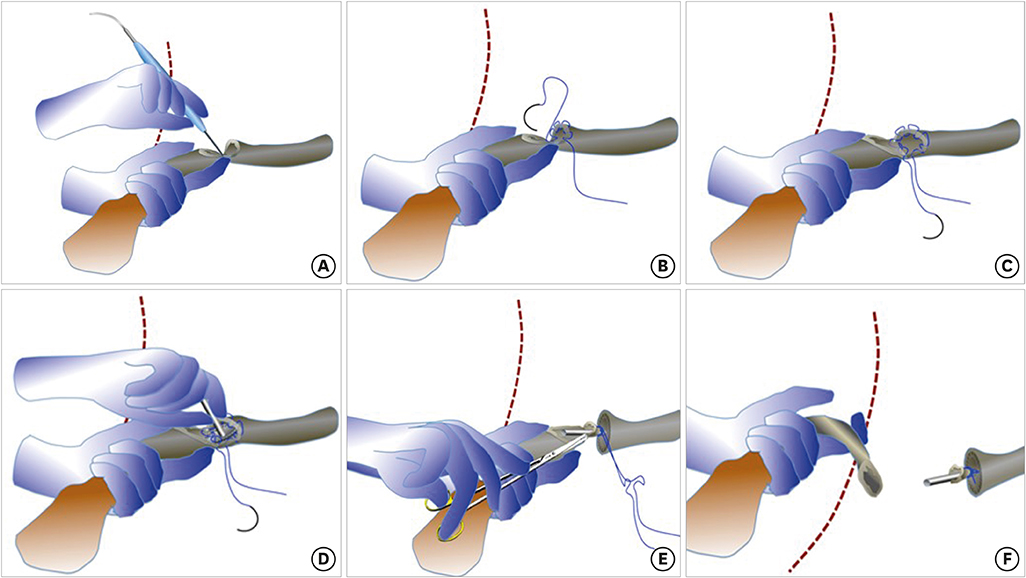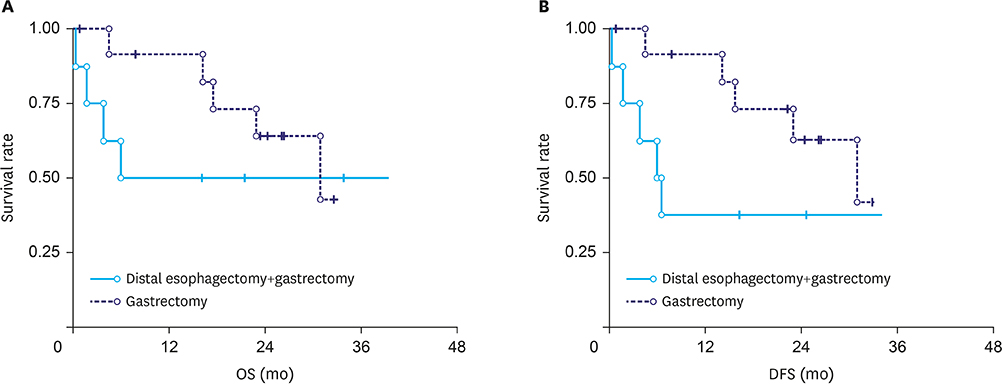J Gastric Cancer.
2019 Dec;19(4):473-483. 10.5230/jgc.2019.19.e35.
Dorsal Track Control (DTC): A Modified Surgical Technique for Atraumatic Handling of the Distal Esophagus in Esophagojejunostomy
- Affiliations
-
- 1Department of Surgery, University Hospital Düsseldorf, Düsseldorf, Germany.
- 2Center of Visceral Medicine, Department of General and Visceral Surgery, Protestant Hospital of Bethel Foundation, Bielefeld, Germany. jan.schulteamEsch@evkb.de
- 3Center of Visceral Medicine, Department of Gastroenterology and Internal Medicine, Protestant Hospital of Bethel Foundation, Bielefeld, Germany.
- 4Department of Thoracic Surgery, Protestant Hospital of Bethel Foundation, Bielefeld, Germany.
- KMID: 2466035
- DOI: http://doi.org/10.5230/jgc.2019.19.e35
Abstract
- Surgical therapy for adenocarcinoma of the esophagogastric junction II requires distal esophagectomy, in which a transhiatal management of the lower esophagus is critical. The "˜dorsal track control' (DTC) maneuver presented here facilitates the atraumatic handling of the distal esophagus, in preparation for a circular-stapled esophagojejunostomy. It is based on a ventral semicircular incision in the distal esophagus, with an intact dorsal wall for traction control of the esophagus. The maneuver facilitates the proper placement of the purse-string suture, up to its tying (around the anvil), thus minimizing the manipulation of the remaining esophagus. Furthermore, the dorsally-exposed inner wall surface of the ventrally-opened esophagus serves as a guiding chute that eases anvil insertion into the esophageal lumen. We performed this novel technique in 21 cases, enabling a safe anastomosis up to 10 cm proximal to the Z-line. No anastomotic insufficiency was observed. The DTC technique improves high transhiatal esophagojejunostomy.
MeSH Terms
Figure
Reference
-
1. Orditura M, Galizia G, Lieto E, De Vita F, Ciardiello F. Treatment of esophagogastric junction carcinoma: an unsolved debate. World J Gastroenterol. 2015; 21:4427–4431.2. Siegel R, Naishadham D, Jemal A. Cancer statistics, 2013. CA Cancer J Clin. 2013; 63:11–30.3. Walsh TN, Noonan N, Hollywood D, Kelly A, Keeling N, Hennessy TP. A comparison of multimodal therapy and surgery for esophageal adenocarcinoma. N Engl J Med. 1996; 335:462–467.4. Blot WJ, Devesa SS, Kneller RW, Fraumeni JF Jr. Rising incidence of adenocarcinoma of the esophagus and gastric cardia. JAMA. 1991; 265:1287–1289.5. Siewert JR, Stein HJ. Classification of adenocarcinoma of the oesophagogastric junction. Br J Surg. 1998; 85:1457–1459.6. Rüdiger Siewert J, Feith M, Werner M, Stein HJ. Adenocarcinoma of the esophagogastric junction: results of surgical therapy based on anatomical/topographic classification in 1,002 consecutive patients. Ann Surg. 2000; 232:353–361.7. Lee IS, Ahn JY, Yook JH, Kim BS. Mediastinal lymph node dissection and distal esophagectomy is not essential in early esophagogastric junction adenocarcinoma. World J Surg Oncol. 2017; 15:28.8. Heger P, Blank S, Gooßen K, Nienhüser H, Diener MK, Ulrich A, et al. Thoracoabdominal versus transhiatal surgical approaches for adenocarcinoma of the esophagogastric junction-a systematic review and meta-analysis. Langenbecks Arch Surg. 2019; 404:103–113.9. Schröder W, Lambertz R, van Hillegesberger R, Bruns C. Differentiated surgical approach for adenocarcinoma of the gastroesophageal junction. Chirurg. 2017; 88:1010–1016.10. Walther BS, Zilling T, Johnsson F, Staël von Holstein C, Joelsson B. Total gastrectomy and oesophagojejunostomy with linear stapling devices. Br J Surg. 1989; 76:909–912.11. Guerra JP, Silva MH, dos Santos JG. An improved technique for a stapled transabdominal esophagojejunostomy. Am J Surg. 1997; 174:61–62.12. Robinson LA, Moulton AL, Fleming WH. Techniques to simplify esophagogastric circular stapled anastomoses. J Surg Oncol. 1994; 57:266–269.13. Hiki N, Fukunaga T, Yamaguchi T, Nunobe S, Tokunaga M, Ohyama S, et al. Laparoscopic esophagogastric circular stapled anastomosis: a modified technique to protect the esophagus. Gastric Cancer. 2007; 10:181–186.14. Ulrich B, Zahedi A. Technical aspects and results of the transhiatal resection in adenocarcinomas of the gastroesophageal junction. Dis Esophagus. 2001; 14:115–119.15. Sato Y, Katai H, Ito M, Yura M, Otsuki S, Yamagata Y, et al. Can proximal gastrectomy be justified for advanced adenocarcinoma of the esophagogastric junction? J Gastric Cancer. 2018; 18:339–347.16. Siewert JR, Fink U, Sendler A, Becker K, Böttcher K, Feldmann HJ, et al. Gastric cancer. Curr Probl Surg. 1997; 34:835–939.17. Omori T, Oyama T, Mizutani S, Tori M, Nakajima K, Akamatsu H, et al. A simple and safe technique for esophagojejunostomy using the hemidouble stapling technique in laparoscopy-assisted total gastrectomy. Am J Surg. 2009; 197:e13–e17.18. Takiguchi S, Sekimoto M, Fujiwara Y, Miyata H, Yasuda T, Doki Y, et al. A simple technique for performing laparoscopic purse-string suturing during circular stapling anastomosis. Surg Today. 2005; 35:896–899.19. Hulscher JB, van Sandick JW, de Boer AG, Wijnhoven BP, Tijssen JG, Fockens P, et al. Extended transthoracic resection compared with limited transhiatal resection for adenocarcinoma of the esophagus. N Engl J Med. 2002; 347:1662–1669.20. Sasako M, Sano T, Yamamoto S, Sairenji M, Arai K, Kinoshita T, et al. Left thoracoabdominal approach versus abdominal-transhiatal approach for gastric cancer of the cardia or subcardia: a randomised controlled trial. Lancet Oncol. 2006; 7:644–651.21. Mariette C, Piessen G, Triboulet JP. Therapeutic strategies in oesophageal carcinoma: role of surgery and other modalities. Lancet Oncol. 2007; 8:545–553.22. Enzinger PC, Mayer RJ. Esophageal cancer. N Engl J Med. 2003; 349:2241–2252.23. Zheng Z, Cai J, Yin J, Zhang J, Zhang ZT, Wang KL. Transthoracic versus abdominal-transhiatal resection for treating Siewert type II/III adenocarcinoma of the esophagogastric junction: a meta-analysis. Int J Clin Exp Med. 2015; 8:17167–17182.24. Walther BS, Oscarson JE, Graffner HO, Vallgren S, Evander A. Esophagojejunostomy with the EEA stapler. Surgery. 1986; 99:598–603.25. Vauthey JN, Maddern GJ, Gertsch P. A simplified technique of esophagojejunostomy. Surg Gynecol Obstet. 1991; 173:499–500.26. Lygidakis NJ. Total gastrectomy for gastric carcinoma: a retrospective study of different procedures and assessment of a new technique of gastric reconstruction. Br J Surg. 1981; 68:649–655.27. Basso N, Minervini S, Marcelli M, Di Marco M. A technical aid in stapled esophagojejunal anastomosis. Surg Gynecol Obstet. 1988; 167:525–526.28. West PN, Marbarger JP, Martz MN, Roper CL. Esophagogastrostomy with the EEA stapler. Ann Surg. 1981; 193:76–81.29. Campion JP, Grossetti D, Launois B. Circular anastomosis stapler. An alternative to pursestring suture. Arch Surg. 1984; 119:232–233.30. Alexander-Williams J. To facilitate the insertion of the EEA autosuture head into the oesophagus. Br J Surg. 1982; 69:196.31. Legaspi A, Irani H. Stapled transabdominal lower esophageal anastomosis without purse-string suture. Surg Gynecol Obstet. 1990; 170:156–158.32. Liu B, Zhang R, Tao G, Lehwald NC, Liu B, Koh Y, et al. Augmented Wnt signaling as a therapeutic tool to prevent ischemia/reperfusion injury in liver: preclinical studies in a mouse model. Liver Transpl. 2015; 21:1533–1542.
- Full Text Links
- Actions
-
Cited
- CITED
-
- Close
- Share
- Similar articles
-
- A modified free gingival graft technique for the treatment of oro-antral sinus track: A case report
- Dorsal Approach for Distal Radius Fractures
- A Novel Technique of Hand-Sewn Purse-String Suturing by Double Ligation Method (DLM) for Intracorporeal Circular Esophagojejunostomy
- Left Dorsal Wall Anastomosis Compared with Parallel-Line Anastomosis for Intracorporeal Overlap Esophagojejunostomy during Laparoscopic Total Gastrectomy
- Direct-to-consumer genetic testing





